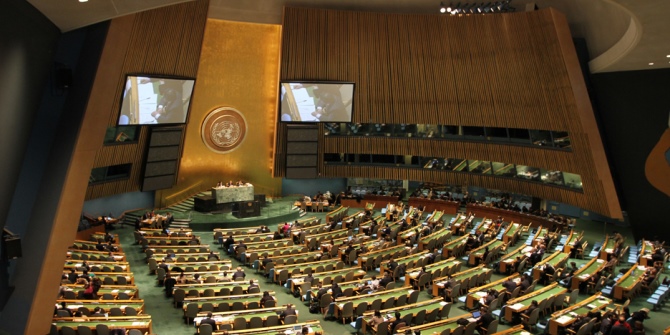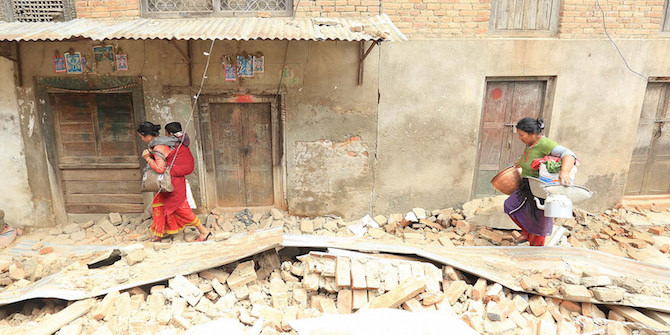In Malevolent Republic: A Short History of the New India, debut author K. S. Komireddi examines the rise of the BJP and Narendra Modi, and the impact of his right-wing Hindu nationalist government on India. While the book offers an open and unabashed critique of the recently re-elected Prime Minister, Nilanjan Sarkar (LSE) finds an informative, pithy and attention-grabbing book that also offers a trenchant critique of the Nehru-Gandhi ‘Dynasty’.
Malevolent Republic: A Short History of the New India. S. Komireddi. London: Hurst & Company. 2019.
Not much is left to expectation when a book has ‘malevolent’ and ‘New India’ in its title. As the world lives through a civilisational turn towards majoritarian insecurity and its politics thereof, Komireddi’s book is an open and unabashed critique of the right-wing Hindu nationalist government in India, led by its poster-boy Narendra Modi, ‘the worst human being ever elected Prime Minister’ (p. 211). But before one castigates the author for his prejudiced perspective, it should be noted that the book begins approximately from 1964 (the death of India’s first Prime Minister Jawaharlal Nehru), and more concertedly from the time of India’s period of political Emergency (1975–77) that was unleashed by the Congress.

The book is in 2 unified parts: the first 4 chapters comprise the ‘Antecedents’ to the rise of the Bharatiya Janata Party/Narendra Modi, while the remaining 6 chapters are on ‘India under Narendra Modi’. A final ‘Coda’ apprehends the national elections of May 2019 (the book was published before the elections, which has brought the BJP back to power with a greater majority for another 5-year tenure). Whilst seemingly about Modi, the book in fact is also a trenchant critique of the Nehru-Gandhi ‘Dynasty’ — beginning with the matriarch Indira (and her lawless son, Sanjay), then Rajiv, Sonia, Rahul (and a bit of Priyanka/Robert), a singular line of political leadership made motley by the interregnums of stooges Narasimha Rao and Manmohan Singh, the only two non-Gandhis to have been made Prime Minister in 40-odd years. Others (Prime Minister Shastri; Home Minister Sardar Patel; &c) make fleeting appearances: together they underline, amplify or mourn malevolence, malfeasance or missed opportunity; cumulatively, this covers almost everything that happened in India’s public/political sphere in the last 50 years. These, and the consequent chapters on the BJP/Modi (including the earlier prime ministership of BJP patriarch Vajpayee), cover a vast, complex and crowded timespan.
To its credit, while almost everyone will find things to disagree with, the book manages to hold the reader’s attention. And here lies an important trick of the book: its language, twinned with detail. Komireddi is master of pithy sentences (‘People victimised by Old India saw [Modi] as one of their own: for some, an agent of their hopes; for others, an embodiment of their rage’, p. 98) which gives speed to his text, and forgotten facts ([Pakistan’s] ‘General Ayub offered himself as pall-bearer for Shastri’, p. 29) which re-centres the reader’s attention at irregular intervals. For someone like this reviewer who has lived through almost the entire time period covered in this book, I was struck by how it was able to keep me engaged, even as my mind alternated between old and immediate causes of despair, resignation and rage. Komireddi’s language is brutal (‘in Sanjay [Gandhi] there wasn’t even a residue of democratic inclination’, p. 32), and the brutality relentless ([Yogi Adityanath] ‘is an unadulterated bigot […] a feral priest enrobed in saffron’, pp 134–35); there is no place to hide ([Manmohan Singh] ‘made history by losing it [the secure Congress seat of Delhi in the 1999 elections]’, p. 80), and he attempts to hide almost nothing (‘The new establishment did not mourn the dead man [Akhlaq]. It supplied alibis for his executioners’, p. 127), sometimes with revolting detail (‘stray dogs tore at the remains of [Narasimha Rao’s] partially cremated body’, p. 78).
The frame of the book is a personal anecdote: the dynamics of the author with his childhood friend Murad. It sets the tone of the partisan, polar and communal reality in the text that follows; it also embodies the hopelessness of the few in New India. A second trick of the book is thus the combining of opinion (‘Muslims were being told by Hindu nationalists — just as they had been told by Muslim segregationist Jinnah — that they could not be Muslim and Indian’, p. 13) with judgement (‘Secularism, it turns out, was a great deal more than the private fetish of a deracinated post-colonial elite. It was, with all its defects, the condition of India’s unity’, p. 189), amplifying the inherent faultlines that keep majoritarian insecurities in place.
It is against this complex background of the remorseless failures of an arrogant Congress that Komireddi articulates his distress at the election of Narendra Modi as Prime Minister, ‘the hand grenade hurled by all those who had been sneered at, stamped upon, marginalized, subjected to cultural condescension and objectified for anthropological amusement by the preening cast of English-speaking elites fostered by India’s venal secular establishment’ (p. 98). His anguish is heartfelt, and some of his predictions (from pre-May 2019) ring true ([India] ‘can no longer invoke the foundational arguments of the state to retain non-Hindus within its fold. Delhi can only hold on to them by force — as second tier subjects of a Hindu imperium …’, p. 190), while some are now redundant ([Modi’s] ‘Hindu nationalism is not even theoretically equipped to defuse the crisis of legitimacy that stalks the state in Kashmir’, p. 190). Kashmir is no longer a state but a dismembered set of Union Territories governed directly from Delhi.
Malevolent Republic is readable, even when one disagrees. The pithy style which lends dramatis to the text also carries the liability of generalisation and, occasionally, dangerous superficiality. While discussing the discipline of History-writing in India, ostensibly under the influence of Nehruvian secularism, Komireddi says: ‘Imperialism, in other words, was destructive only when Europeans did it. When Asians did it, it was a cultural exchange programme’ (p. 70). What Komireddi’s pithiness belies — like those of so many current politicians and commentators who invoke History — is the complex subjectivity of historical data that cannot be captured in brevity. To counter this statement from a slightly more informed perspective, Komireddi ought to have considered that ‘Europeans’ are ‘imperialists’ because they never settled in India and made it their home; the Muslims did. And it is that choice of settlement in what was to Muslims initially a foreign land that what Komireddi sarcastically calls a ‘cultural exchange programme’ occurred. History is not for bytes, nor for the present; it is a discipline to study the past. Perhaps this is too fine a point to make here, but in a world where non-historians invoke History and its ‘wrongs’ to disaggregate the present to justify victimhood, and downward spirals of violence and discrimination against co-citizens, a case ought to be made for greater responsibility by all. Otherwise we risk not just distorting History and humanity, but losing much else in this bellicose march towards majoritarian nationhood.
This article gives the views of the author and not the position of South Asia @ LSE blog, nor of the London School of Economics. Please read our comments policy before posting. Photo: ‘Every Vote Counts’; Credit: Incredibly Numing, Creative Commons.








What about the Kashmir Genocide ?
The Ruling political dispensation of India (Hindoosthan) is a front of the RSS (a quasi wanna be Nazi party).The RSS in its documented history and intellectual posits has admired and co-opted and co-owned Hitler – not merely as a Role Model – but as a Kalki Avatar – or an Avatar of Vishnoo – the Hindoo God !
The SS part of the RSS is a lift from the Nazi SS and the “R” stands for “Rats”
The RSS is infested by the vermins of the Brahmin/Bania/Kayastha triad – which represent the priestly and trading classes of Hindoosthan who never fought a war for their nation – but incited the same and also carried out the largest unknown genocide in History – that of the Buddhists
The Bhagwad Gita JUSTIFIES genocide, w/o remorse,guilt and WITH DIVINE SANCTION.The Indian Military and Para Military,is a race of criminal mercenaries called Kshatriyas – who were the offspring of rapes by the Huns,Mongols,Sakas, Scythians,Persians, Parthinians,Greeks 1500-2000 years ago.They were discarded by their races and interbred and were treated as outcastes for centuries – until the Brahmins co-opted them as criminal mass murderers (around 1000 years ago) – and who are now in Kashmir !
Nazis are on record JUSTIFYING their actions based on the thesis of the Bhagwad Gita explained in this note.
History Records that the Nazis were ALSO inspired by the Gita, per se
https://dindooohindoo.page.tl/Nazis-and-Gita.htm
Why the “Nazis and Hitler and Himmler”, love the Gita
“Dindoo Hindoo Bindoo Gandoos” consider “Hitler to be a Vishnoo Avatar”
When Krishna the Bhagvat was fed up rying to explain to “Arjuna the – why he “needed to exterminate his foes” – this was the “last attempt” in the 18th Chapter of the Gita – the logic is as under :
Lumen Naturale 1 – There are “5 precedents to sense-perception and action”
मूल श्लोकः
शरीरवाङ्मनोभिर्यत्कर्म प्रारभते नरः।
न्याय्यं वा विपरीतं वा पञ्चैते तस्य हेतवः।।18.15।।
18.14 The locus as also the agent, the different kinds of organs, the many and distinct activities, and, the “divine is here the fifth”.
Lumen Naturale 2 – There “5 are causes of all action” and are “independent of the mind and body dualism” of Descartes and “also the Soul “!
मूल श्लोकः
यस्य नाहंकृतो भावो बुद्धिर्यस्य न लिप्यते।
हत्वापि स इमाँल्लोकान्न हन्ति न निबध्यते।।18.17।।
18.15 For whatever action a man undertakes by his body, speech and mind, whether right or wrong,i.e., enjoined or forbidden by the Sastras, “the following five”, are its causes:
Lumen Naturale 3 – Hence,you can “kill,murder and rape” – provided it is done with “no ego and no feelings “- for it is the “Act of the Divine” ! Just like the Nazis ! “Heil Krishna,the Bhagwat “!
मूल श्लोकः
अधिष्ठानं तथा कर्ता करणं च पृथग्विधम्।
विविधाश्च पृथक्चेष्टा दैवं चैवात्र पञ्चमम्।।18.14।।
18.17 He who has not the “feeling of egoism”, whose intellect is not tainted, he does not kill, nor does he become bound-“even by killing these creatures” !